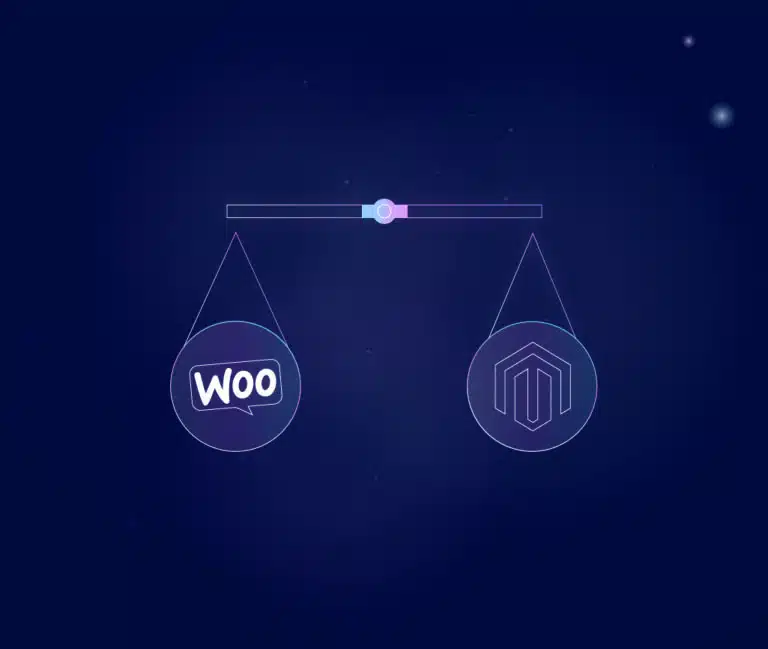Design
11 minute read
WooCommerce Vs Magento: Which Platform Comes Out on Top?.
LAST UPDATED:
August 15, 2023


Choosing between the biggest and most popular eCommerce website builders can be overwhelming.
With WooCommerce and Magento dominating the market, it can take a lot of effort to figure out which platform is better for your online store.
To start, WooCommerce and Magento differ in their core function.
WooCommerce is an eCommerce plugin for WordPress websites. On the other hand, Magento is a full-fledged eCommerce platform, like Shopify.
If you’re using WordPress as your primary store, we highly recommend using WooCommerce.
However, if you’re looking for an alternative eCommerce platform, then Magento is an excellent option.
But like all things, it’s never that simple.
That’s why we’ve made this blog post to dive into WooCommerce and Magento’s details and compare them across key metrics like cost, customizations, security, and more!
So let’s get started! Which will it be — WooCommerce or Magento?
It’s essential to get familiar with the history of these two eCommerce platforms to understand how they became such popular choices for online stores.
WooCommerce and Magento have each carved out their tech history since they first appeared on the web.
WooCommerce made its debut in 2011 as a plugin for WordPress and quickly skyrocketed to be used by nearly four million websites. Automattic, the team behind WordPress, now owns the plugin.
While that was happening, Magento quietly started making a name for itself in 2008, becoming known for its expansive features and customization options.
It’s now owned by Adobe, and unsurprisingly, over 250,000 businesses rely on Magento to drive their eCommerce presence.
But it’s not just history that makes them unique. It’s their features.
When comparing the two, there are several key differences you should be aware of.
Let’s look at what makes these two options stand out.
Subscription Costs
WooCommerce
WooCommerce may be free to install, but that doesn’t mean you have to skimp on features. The initial setup costs nothing, but subscription-based add-ons could sweeten the deal.
These can include integrations to get the full benefit of your online store, premium content delivery services, and more.
The subscription costs could save you money by sprucing up your website’s functionality — with no need for pricey updates or outdoing mediocre technology.
Magento
Two Magento versions are available for any digital shopkeeper to explore: the free, open-source version and a paid version which starts at $22,000 per year.
For those not used to spending that kind of cash on their business, don’t worry. With features like custom notification emails, payment gateways, and PCI compliance already baked in, this scaling cost might be a wise investment for taking your store to the next level.
Who Wins?
WooCommerce stands out on subscription costs because of its cost-effectiveness, allowing you to make the most of extensions and additional integrations on an as-needed basis.
It provides ample customization options for you with great features at relatively low prices so that you don’t have to settle for anything less than exactly what you need to build the perfect online store for your business.
Theme Design and Customization

WooCommerce
With WooCommerce, you have all the freedom and convenience you could want when transforming your website into something that captures the essence of your business.
This easily makes it one of the best eCommerce platforms for small businesses with small web development budgets.
From an expansive library of custom-made themes to hundreds of color and font options ready for you to experiment with, it’s no wonder why so many entrepreneurs fall in love with WooCommerce.
With simple drag-and-drop tools and the ability to add custom CSS, making basic tweaks on your site becomes a breeze even if HTML isn’t your thing — perfect for small business owners who don’t have the time (or tech experience) to dive deeper into web design.
Magento
Magento is for the ambitious business owner who will only settle for perfection.
Their design and customization capabilities are top-notch; it offers themes produced by Adobe and third-party developers so you can find the perfect look and feel for your store.
If that isn’t enough, Megento makes customization even more accessible by offering multi-store views based on language or currency and B2B functionality for those using a wholesale model.
That said — customized sites aren’t easy to build in Magento.
There’s still some technical know-how or the help of a skilled developer required to take advantage of Magento’s excellent capability.
Who Wins?
If you’re looking for a powerful platform for theme development, then WooCommerce is ideal — providing plenty of options for small businesses.
But if you need something more robust, choose Magento. Its strength lies in its ability to cater to larger companies.
For daily convenience, though, it’s hard to beat WooCommerce’s user-friendly interface — making it an obvious choice for those without time.
Plugins and Integrations
WooCommerce
With WooCommerce, you can add custom features to your existing website without learning complex code.
Whether you’re creating a mobile shopping experience or integrating with your current payment processor, WooCommerce offers a wide selection of plugins and integrations that can work on any budget.
But just because there are so many options doesn’t mean you’ll have an easy time choosing.
WooCommerce doesn’t have an official review process for its plugins and extensions.
While you may be spending your hard-earned money on something that could be the perfect fit for you, there’s still no guarantee that it will work the way you want.
Don’t worry, though. Their support unit has you covered. They’ve created resources to help troubleshoot any issues that might arise, so you know you’re getting the best out of your WooCommerce experience.
Magento
You can customize your store with Magento’s huge variety of plugins and integrations.
With Adobe powering the system, you can access a massive library of enhancements from trusted developers.
Plus, if you’re looking for something unique or specialized, there’s a robust marketplace full of extensions that have been screened for compliance before being offered to consumers.
Whether you want seamless compatibility with the latest technology or just an excellent new eCommerce feature, Magento integrations and plugins can help.
Who Wins?
For the tech-savvy and those comfortable debugging issues — or those just looking to save some extra cash — WooCommerce provides a wide range of easy-to-use plugins that often require little effort to use.
On the other hand, if quality assurance, reliability, and structure are more important than saving a buck or two, Magento’s more strictly-reviewed products might be just right for the job.
Search Engine Optimization

WooCommerce
WooCommerce offers several features to help you optimize your store for search engine visibility. You can create more targeted content with customizable page titles and meta descriptions that search engines will pick up.
Additionally, WooCommerce allows you to create custom URLs that make it easier for search engines to find and index your pages.
Magento
Magento also offers robust SEO options to help improve a website’s search engine visibility.
Through customizable page titles and meta descriptions, users can create more targeted content that search engines are more likely to pick up.
Magento also lets users create custom URLs that make it easier for search engines to find and index pages.
Moreover, Magento has built-in support for Google Rich Snippets, a feature that can make your search results stand out and be more informative.
This allows customers to get the information they need more efficiently without clicking through multiple pages or search results.
Who Wins?
While both options are plentiful, Magento’s more robust SEO tools and features make it easier for store owners to optimize their websites for higher search visibility.
Its support for Google Rich Snippets gives it an edge over WooCommerce for enhancing search results with relevant product information quickly and conveniently for customers.
With better optimization strategies, Magento stores may outperform WooCommerce stores in visibility and conversions from organic search traffic.
Security
WooCommerce
WooCommerce offers a few security features by default, including SSL for secure payments and account creation.
This ensures that sensitive customer data is securely encrypted and sent while transacting with your store.
Furthermore, WooCommerce offers various free and paid plugins for additional layers of security.
Magento
Magento offers an SSL connection for payments and account creation and supports two-factor authentication.
This provides an extra layer of security to keep customer data safe and gives users peace of mind when shopping online.
In addition, Magento has a wide range of extensions that you can add to enhance security measures.
These include:
- Customer segmentation
- File encryption
- Fraud protection
- SQL
- Two-factor authentication for admin access
- Data loss prevention protocols
With all these features available, customers can shop without worry, knowing their information is safe and secure.
Who Wins?
Both WooCommerce and Magento make it easy to up the ante with SSL-protected sites and the ability to add extra security layers through plugins or extensions.
But here’s where Magento stands out: with its built-in support for two-factor authentication, its users have an extra level of security that can make all the difference — especially for those with high-value items or sensitive data.
Maintenance Costs and Long-term Support
WooCommerce
With WooCommerce, you get reliable support and maintenance you can count on.
Long-term stability is woven into its core, as frequent updates keep things running smoothly and efficiently.
In addition, there is also a vibrant community of developers who are continuously working to make WooCommerce better for everyone.
At last count, around seven million websites have chosen WooCommerce for their online business needs!
Magento
With Magento, updates frequently occur — from fast-paced minor tweaks every three months to extensive yearly upgrades — giving you peace of mind that your business is running on the latest version.
Additionally, paid customer support plans ensure you’ll always have access to helpful resources such as community forums and documentation activities if you ever encounter difficulties.
Further, with a large community of developers (over 160,000 websites use Magento), plenty of people can advise when you need it.
Who Wins?
For people comfortable troubleshooting their technical issues, WooCommerce may be the best fit.
With a larger community of developers to call on for help and no paid customer support plans required, WooCommerce could provide an edge in terms of cost savings and convenience.
On the other hand, if you’re in over your head with website issues and need additional assistance, Magento’s paid customer service packages may work better for you, providing qualified techs who can tackle more advanced concerns.
Don’t be afraid to roll up your sleeves and tinker with WooCommerce — but if things get too complicated, there are plenty of options with Magento.
How does WooCommerce stack up on our platforms list? We say it’s pretty high!
There’s a lot to love about WooCommerce, and here are some things that may make it the best fit for your store.
Customization
Customization is a significant benefit of WooCommerce.
Its open-source codebase allows you to customize almost any aspect of your online store with custom plugins, themes, and extensions — from payment gateways to inventory tracking.
You can also take advantage of third-party apps and services to extend the functionality of your store even further.
This versatility makes WooCommerce an excellent choice for anyone looking for an eCommerce solution that’s tailored to their needs.
Great Community Support
Using an open-source platform means you have access to the knowledge base of a large community of developers that are willing to share their expertise and help out with any issues you may encounter.
Whether you’re stuck on a coding issue or need help optimizing your store, the community at WordPress and its associated forums are always happy to lend a hand.
This support can be invaluable when setting up and running an eCommerce business.
Standard SEO Functionality
Having a website that is optimized for search engines is essential if you want customers to be able to find you online.
Luckily, WooCommerce offers standard SEO functionality right out of the box, so you don’t have to worry about doing any additional coding or hiring someone else to do it for you.
From meta tags and sitemaps to keyword targeting and link optimization, all the elements necessary for effective SEO are automatically built into the platform, giving your store an edge over competitors who don’t have SEO-friendly websites.
While we love WooCommerce, it’s not perfect and lacks features for big eCommerce stores. This is where Magento comes in. However, Magento has several paid alternatives. (For more reading, check out 4 Reasons Why Brands Migrate From Magento to Shopify Plus!)
While they’re all similar, Magento has advantages that will make it more enticing for larger businesses.
Diverse Marketplace Options
One of the best things about Magento is its many different marketplace options.
These allow you to customize your store to fit your specific needs. Whether you own a small shop or run a large enterprise, there’s an option for everyone.
From multi-store management to third-party integrations, Magento offers everything you need to build an online store tailored to your customers’ needs.
Scalability
Another great thing about Magento is that it is highly scalable.
As your business grows and evolves, so can your website! Whether you need more bandwidth or storage space, Magento can handle any increase in demand without sacrificing performance or functionality.
This makes it easier to grow your business without worrying about constantly switching platforms or updating software.
Enhanced Security
Finally, Magento takes security seriously — which is essential when dealing with sensitive customer information like credit card numbers and addresses.
Their platform includes built-in tools like two-factor authentication and data encryption that help keep customer data safe from malicious actors online.
Plus, they offer regular updates so their users can stay up-to-date on the latest security trends and changes in the industry — helping them stay one step ahead in keeping their customers safe and secure while shopping at their stores!
Which one is for you? Ultimately, choosing between WooCommerce and Magento will depend on your specific needs.
Both platforms offer great features that make them suitable for any eCommerce venture — from small businesses to large enterprises.
WooCommerce is an excellent option for anyone looking for an easy-to-use platform with lots of customization options.
At the same time, Magento’s extensive marketplace and scalability make it better suited to larger stores.
If you need help choosing your eCommerce platform, we’re here to help.
Huemor is a digital agency with years of experience designing and developing eCommerce websites — so contact us and let us know what you need! We’d love to help you create the perfect online store.
Get Memorable Insights.
Sign up to receive actionable web design advice directly in your inbox monthly.
Get Memorable Insights.
Sign up to receive actionable web design advice directly in your inbox monthly.
Author
Jeff Gapinski is the President of Huemor where he helps plan the long-term strategic growth of the agency. Jeff is passionate about UI/UX, demand generation, and digital strategy.
What Do You Think?
Have feedback? Maybe some questions? Whatever it is, we'd love to hear from you.




![Website Design Standards We Follow [That You Should Too!]](https://huemordev.b-cdn.net/wp-content/uploads/2021/12/2023.04.04.Website-Design-Standards-We-Follow-That-You-Should-Too.jpg.webp)



No comments found